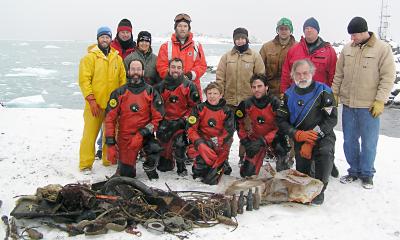Seems Sietch members were not the only ones doing an earth day cleanup, residents at Palmer Station, a year-round U.S. research station on the Antarctic Peninsula, removed old debris from the sea floor near the station in late April 2007, as a part of an annual Earth Day clean up. Could they have been inspired by our clean up? Who knows.
In the early days of Antarctic exploration, in the first decades of the 20th century, expeditions were largely unregulated and free to dispose of wastes as the leaders saw fit. In the latter half of the century, following renewed efforts to explore the polar regions that were sparked in part by worldwide interest in the continent and a burgeoning, global environmental consciousness, nations began to develop environmental policies for Antarctica as well as efforts to mitigate past environmental harm.
The international Antarctic Treaty, to which the United States is a signatory, contains a Protocol on Environmental Protection that designates Antarctica as a “natural reserve, devoted to peace and science,” and sets forth basic principles and detailed, environment-related obligations applicable to human activities in Antarctica.
The National Science Foundation (NSF) oversees the U.S. Antarctic Program, which manages three year-round stations on the southernmost continent and coordinates all U.S. scientific research there. The White House has designated NSF as the lead U.S. Agency for the International Polar Year 2007-2008, a concerted global research effort in the polar regions.
